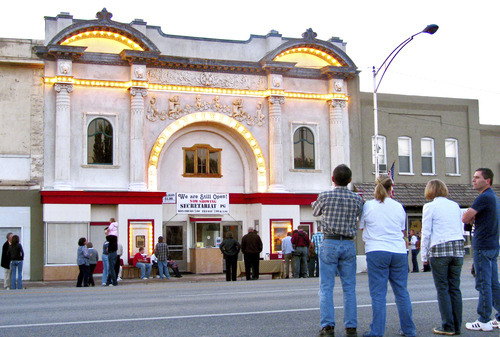This is an archived article that was published on sltrib.com in 2010, and information in the article may be outdated. It is provided only for personal research purposes and may not be reprinted.
Gunnison • The future looks bright for Gunnison's historic but star-crossed Casino Star Theatre.
Carol Anderson, whose family owned the theater for three decades, switched on the lights Friday night to illuminate the building's reconstructed stucco façade.
The crowd cheered Anderson and the two women who have been steadily restoring the building, despite unusual setbacks, since 2004.
Gunnison Mayor Lori Nay and retired Snow College professor Diana Spencer knew they had a lot of work ahead of them when they formed the nonprofit Casino Star Theatre Foundation to finance the building's purchase and repair. But they never considered giving up on it.
"Quitting wasn't an option," Nay says. "It needed to be saved."
That's the city's sentiment. Since it opened in 1913, the theater has played some part in the lives of everyone who grew up in Gunnison. Anderson lived with her late husband, Keith, in an upstairs apartment for about eight years while they ran the concessions for her father-in-law, Cyrill E. Anderson. She delivered two of her children in the theater.
The Star was built as the "Casino Theatre" in 1912 by entrepreneur Sims Duggins who had moved from Provo to Gunnison to cash in on the area's sugar beet industry. Duggins had the Beaux-Arts School of Architectural Design in Paris draft the plan for the façade. A Pittsburgh company built the frieze and columns and shipped them to Utah by rail.
Over its 98-year history, the building hosted plays, vaudeville acts, movies and possibly a speakeasy. But by the turn of the century the roof leaked, the back rooms, basement and upstairs apartment were filled with dusty clutter, the interior plaster walls were melting and the façade was crumbling.
While Nay and Spencer addressed those issues, more problems developed. In 2007, a gasoline leak from a nearby Top Stop gas station seeped into the tunnels beneath Main Street and filled the theater with fumes. When they closed the business, they lost its "grandfathered" status under the county's building codes. The county inspector told them they would have to replace the ornate silk curtains with nonflammable materials, and make other fixes.
The gas leak and the resulting closure forced Nay and Spencer to shift their priorities to the building's exterior. Contractors began tearing down and restoring the façade in 2008. Much of the walls, the trim and the columns were too far gone to fix and had to be completely rebuilt.
Now that the façade is glowing, the next step will be to paint it, then apply a "breathable sealant" that will allow water vapor to escape, Spencer said. However, she says they won't paint until spring, to give the stucco time to cure.
The two want to remove the wall beneath the main arch and take out the ceiling of the lobby to expose the magnificent barrel-vault ceiling and its plaster rosettes and intricate trim.
Nay and Spencer also want to replace the marquee over the ticket office. In fact, there's no end to the things they want to do.
But the glowing lights above the entrance at night are proof they are making progress.



